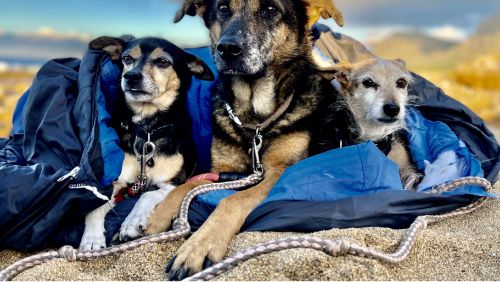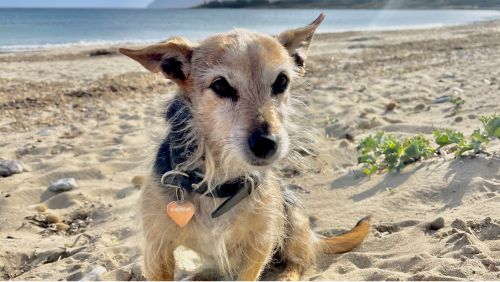Exploring Mallorca with Your Dog: Travel Planning & Excursion Tips

Stunning beaches, idyllic landscapes and numerous charming locations make Mallorca one of Europe's most popular holiday destinations. Many dog owners therefore wish to visit the island with their four-legged friend and perhaps discover less touristy areas. With the right preparation and planning, there's nothing standing in the way of a holiday with your dog in Mallorca. Here you'll find all the important information for travel preparation and helpful tips for a carefree time with your canine companion in Mallorca.
Table of Contents
What is the best time to visit Mallorca with your dog?
Without question, Mallorca offers the best conditions for a dream summer holiday. While pure sunshine sounds like paradise for humans, the high temperatures during the summer months are usually too stressful for animals. For a Mallorca holiday with your dog, we therefore recommend the off-season in spring or autumn (March to May and September to October). These months offer numerous advantages – not only for your pet. Outside the high season and holiday periods, the island is less crowded, which means that attractions, hiking trails and beaches are less busy. Additionally, spring and autumn offer pleasantly mild weather, which is ideal for activities with your dog.
Dog-friendly accommodation in Mallorca
Mallorca has numerous dog-friendly accommodations, including holiday homes, fincas and hotels. When booking, make sure that pets are explicitly allowed. Some accommodations charge an additional fee for final cleaning. Particularly recommended are holiday homes or apartments with a fenced garden, which provides your dog with a safe area to run around.

Visiting Mallorca with your dog: Entry requirements and health precautions
To ensure your holiday with your dog in Mallorca starts smoothly, thorough travel preparation is necessary. On one hand, you should check the entry requirements for dogs to Spain, and on the other hand, ensure that your four-legged companion is completely fit for travel.
Entry requirements for dogs
Basically, EU entry requirements for pets apply in Spain. The following conditions must be met:
- EU pet passport required: Your dog needs a valid EU pet passport, which is issued by the vet. This contains all necessary information and descriptions of an animal (such as the owner's contact details and the microchip number) as well as all necessary health data (e.g. proof of vaccinations).
- Microchip: An implanted microchip is also mandatory. Tattoos for identification are only permitted if they were applied before 03/07/2011 and are clearly legible.
- Rabies vaccination: As in all EU countries, proof of a valid rabies vaccination is mandatory.
The vaccination must be at least 21 days old. Booster vaccinations must have taken place at the required
interval.
Note: Puppies can only be vaccinated against rabies from 12 weeks of age. Since the vaccination needs at least 21 days to develop effective protection, puppies can only enter from an age of at least 15 weeks.
For dog breeds that are classified as potentially dangerous and in Germany are known as "fighting dogs", additional requirements may apply – such as a muzzle requirement. You should inform yourself about the local regulations for individual breeds before starting your journey.
Is there a leash requirement?
Basically, there is a leash requirement throughout the island. This means that your dog must always be on a lead in public areas. On site, you will certainly discover some dog owners who do not adhere to this regulation – however, we recommend not taking any risks. Especially dogs with a strong hunting instinct should not be let off the lead, as you may encounter street cats and, in the natural hinterland of Mallorca, also wild goats or sheep. At designated dog beaches, on the other hand, you can let your four-legged friend off the lead without hesitation, as long as they reliably respond to your recall.Health precautions for a stress-free Mallorca holiday with your dog
Thorough health precautions are essential if you don't want to leave your four-legged friend behind when travelling. There are some diseases that are mainly transmitted by ticks or mosquitoes living in the Mediterranean region and pose a high risk to dogs.
To protect your dog as best as possible, you should take some precautions before travelling:
- Leishmaniasis is mainly transmitted by sand or butterfly mosquitoes. Since it is very dangerous for dogs and not curable, infection should definitely be prevented. Parasite protection in the form of repellent collars or spot-on preparations is essential if your dog is accompanying you to the Mediterranean region. In addition, vaccination against leishmaniasis is possible, which offers the best protection in combination with parasite repellents.
- Dirofilariasis ("heartworm disease") is transmitted by mosquitoes and can also have a severe course. Timely prophylaxis with appropriate medications best protects your dog from heartworms.
- Babesiosis and Ehrlichiosis are two tick-borne diseases that can cause various serious symptoms. Unlike leishmaniasis, these diseases are curable if treated promptly, but still very dangerous and can also develop a chronic course. Effective tick protection through collars, spot-on preparations or tablets is therefore very important.
Through vaccinations or special parasite protection products, you can effectively protect your dog from infection with the so-called "Mediterranean diseases". Which protection method is most suitable should be discussed with your vet.
Our tip
In addition to your own travel first aid kit, also pack a first aid kit for your dog – including disinfectant, bandages and a herbal remedy for diarrhoea. For more serious illnesses, you can rely on veterinary care in Mallorca. In almost every larger town there is a resident vet, and in Palma there is also a veterinary clinic. Many Mallorcan vets speak English, some also German.
Mallorca holiday with your dog: Travelling by plane or ferry?
When planning your Mallorca holiday with your dog, the question of how to get there naturally arises. Many holidaymakers reach the island by plane. However, flying with a dog requires careful planning and preparation. Therefore, find out early from the airline about the applicable regulations for pets:
- Transport in the cabin: Dogs up to about 8 kg (including transport bag) are allowed to travel in the cabin with many airlines. The bag must comply with the airline's dimensions and fit under the front seat.
- Transport in the cargo hold: Larger dogs must be transported in the air-conditioned cargo hold. Choose a sturdy transport box approved by the airline. However, also note that this type of travel can be very stressful for many animals – if your pet is very anxious or has health problems, you should ideally consider another travel option.
For the most comfortable journey possible, it's important that you get your dog used to the transport box early. If your four-legged friend perceives the transport box as a safe retreat, the stress during the flight can be minimised. On the day of arrival and departure, it's advisable to allow sufficient time for check-in and security control and to have all necessary documents ready.
Alternative travel option: Ferry to Mallorca with your dog
If travelling by plane is too stressful for your dog, you can also reach Mallorca by ferry from mainland Spain. Various ferry companies offer connections from Barcelona, Valencia or Dénia to Mallorca. Many ferries provide special dog cabins where four-legged friends can stay with their owners. Since these cabins are quickly booked up, you should reserve early.
Getting around Mallorca with your dog: Hire car or public transport?
If you want to experience the cultural and scenic diversity of Mallorca, you naturally cannot stay in just one place. Therefore, the question arises, with which means of transport you want to travel together with your four-legged friend: With a hire car or by bus and train? Both options have their advantages and disadvantages:
- Booking a hire car: A hire car offers you the most flexibility when exploring the island. Most providers allow the transport of pets, however, an additional cleaning fee may apply. Therefore, inform yourself exactly about the conditions of the car hire provider before booking.
- Taking the bus, metro or train: Since 2024, pets are allowed to travel on the island's public transport – previously this was only possible on city buses in Palma. Small pets (including dogs) must be kept in a transport box during the journey. If your dog is too large for a transport box, they can travel on a lead and with a muzzle. In this case, a ticket must also be purchased for the dog.
Regardless of which means of transport you ultimately choose – it is recommended that you gradually get your dog used to transport in the car or travelling on public transport at home. This way, you avoid additional stress for your four-legged friend in an already unfamiliar environment.
Dog-friendly activities: Hikes and dog beaches in Mallorca
Mallorca's multifaceted landscape attracts countless visitors to the island every year. If you like to spend time outdoors with your dog, you'll definitely get your money's worth on the island – whether during extended walks, hikes or relaxing beach days. To make planning easier for you, we've collected some suggestions:
Hiking in Mallorca with your dog
The diverse landscape of Mallorca is a paradise for hiking enthusiasts. In advance, you should inform yourself exactly about the planned routes to ensure that the duration and difficulty level are suitable for you and your pet. For example, hikes with climbing passages are difficult to manage with a dog. Here are some recommendations for dog-friendly hikes:
- Hike to Caló des Màrmols
- Circular hike around Cala Mesquida
- Circular hike around the Cúber reservoir
- Historical tour through Palma
Detailed route descriptions and further recommendations can be found online, for example on Alltrails or Outdooractive. Note that leash requirements also apply on most hiking trails.
Dog beaches in Mallorca
Sunshine and pleasant temperatures invite you to enjoy a fun day at the beach. To allow your dog a
well-deserved cooling off, you can visit one of the designated dog beaches in Mallorca.
In these designated areas, your dog is allowed to run freely, play around and also
swim in the water.
The following dog beaches are worth a visit:
- Cala Blanca (Andratx)
- Cala d'Egos (Andratx)
- Cala des Gats (Calvià)
- Cala Punta Marroig (Calvià)
- Playa de Alcanada (Alcúdia)
- Playa de Es Carnatge (Palma)
- Playa de Llenaire (Port de Pollença)
- Playa de Na Patana (Santa Margalida)
Our tip: During the high season, dogs are strictly forbidden on bathing beaches. In the off-season, however, some municipalities relax their regulations and allow four-legged friends access to the beach. In the following locations, you can take the opportunity for extended beach walks with your dog:
- Beaches in Andratx, Capdepera and Pollença from October to April
- Beaches in Artá from November to March
- Beaches in Muro from November to February
Please note that, unlike at designated dog beaches, leash requirements still apply at these beaches. Whether at a bathing beach in the off-season or at a natural dog beach, you must of course remove your dog's waste. Then nothing stands in the way of a relaxed beach day together.
How to successfully visit restaurants during your Mallorca holiday with your dog?
Finding a shady spot in a café in the afternoon or ending the evening in a cosy restaurant: Of course, culinary experiences should not be missed during your holiday with your dog in Mallorca. Most cafés and restaurants in Mallorca welcome dogs – especially if they have an outdoor area. To be sure, you should of course ask in advance if dogs are allowed. Furthermore, you should ensure that your four-legged companion does not disturb other guests.